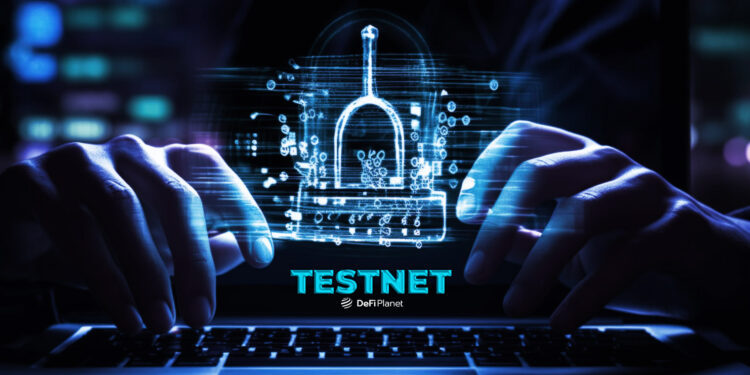Testing new products or features directly on a live blockchain can be risky, as potential vulnerabilities might be overlooked. These oversights could lead to financial losses or make the blockchain susceptible to threats.
Testnets act as a safety net by enabling developers to identify and fix errors before the feature goes live. To ensure proper functionality and mainnet stability, developers often experiment with different security configurations during testing.
This article comprehensively explores testnet and why it is essential in blockchain development and management.
What is a Testnet?
Testnet, as the name implies, is a part of the blockchain network designed for testing purposes. It’s like a practice version of the mainnet, allowing users and developers to experiment with new ideas and applications without any cost or impact on the actual network.
Testnets are crucial in blockchain development. They provide a safe and effective space for developers to build, test, and deploy applications.
This environment ensures thorough evaluation before applications go live on the blockchain, offering developers the chance to improve their creations before deploying them on the mainnet.
Additionally, developers can experiment with new features, test smart contracts, and create applications without the need for real money or risking untested codes, which can be challenging to modify once deployed on the mainnet.
Testnet helps developers to collect community feedback and refine their products before making them publicly available.
How Does a Testnet Work?
Testnest works much like beta testing in software development; community members and interested users are invited to try out new features or products and share valuable feedback for improvement.
For most testnets, the user has to link their wallets and collect Testnet tokens using a crypto faucet. These tokens are provided in small amounts and hold no real-world value. They enable users to engage with the blockchain without any risk of losing their actual assets.
Participants need to do tasks like finding issues in a bug bounty program, testing a feature in a dApp, or sharing about the Testnet on social media. Afterwards, they can leave a review, helping internal developers address any flaws before the Mainnet launch.
Testnets vs Mainnets
While testnets closely resemble mainnets, there are notable differences that set them apart from each other. Understanding these distinctions is crucial for developers and users engaging in testing and experimentation.

What Developers Use Testnets For
- Separate Development: Testnets offer a separate environment for developers to experiment freely, ensuring they can innovate without concerns about vulnerabilities or affecting the main network.
This isolation allows for a flexible and iterative development process, promoting innovation and creativity in the development cycle.
- Consensus Mechanism Testing: Testnets enable developers to experiment with diverse consensus mechanisms and understand their impact.
Exploring various protocols helps developers assess the performance, scalability, and security of their chosen mechanism, leading to optimizations that enhance the network’s overall efficiency.
This experimentation phase is crucial for ensuring a well-functioning and secure consensus mechanism in the live blockchain environment.
- Smart Contract Testing: Testnets play a vital role in testing and deploying smart contracts. Smart contracts are agreements that execute actions automatically based on predefined conditions.
Testnets enable developers to conduct comprehensive testing on these contracts, guaranteeing their reliability and security before deploying them on the mainnet.
This ensures a robust and secure execution of smart contracts in the live blockchain environment.
- Network Upgrades: Testnets are perfect for testing network upgrades and new protocol implementations. By simulating these changes on a smaller scale, developers can pinpoint and fix any potential issues, ensuring the mainnet’s stability and functionality are improved.
This iterative testing process plays a crucial role in maintaining a robust and smoothly operating blockchain network when upgrades are eventually deployed to the broader audience.
Benefits of Running a Testnet
The primary goal of a testnet program is to guarantee the mainnet’s smooth operation. In addition to that, here are some benefits:
- Enhances Network Security: While blockchain and smart contracts strive for tamper-proof functionality, potential flaws may exist.
Engaging external developers in bug detection programs helps uncover blind spots that internal developers can address and fix.
This collaborative approach fortifies network security, ensuring a comprehensive and robust network performance.
- Enhances User Experience: By incorporating feedback from Testnet participants, internal developers can fill gaps and enhance existing features to create a product that aligns better with user needs. This continuous feedback loop contributes to an improved overall user experience, fostering user loyalty and satisfaction with the platform.
- Strengthens Community Building: Using a Testnet provides developers with exposure and hands-on experience with new blockchain tools and documentation. Simultaneously, users become acquainted with new decentralized applications (dApps) and might share their experiences on social media.
- Learning Opportunity: Testnets offer a valuable learning space for aspiring developers and enthusiasts. Participating in testnets allows individuals to gain practical experience in blockchain development, smart contract deployment, and network management.
This hands-on engagement contributes to the development of a skilled and knowledgeable community.
Types of Testnets

There are primarily two main types of testnets — Public and Private.
- Public Testnets: Public testnets are open networks accessible to anyone with an internet connection. Utilizing widely-used wallet interfaces like Metamask, individuals can easily connect to these networks.
Examples of such public testnets include Rinkeby, Bitcoin testnet, and Kovan. These environments allow users to experiment and test without restrictions.
- Private Testnets: Private testnets are like personalized versions of a blockchain, ideal for internal collaboration and controlled experiments.
They allow teams to simulate activities, like mining and transaction confirmations, without the threat of external attacks.
This controlled setting ensures a secure space for testing and refining blockchain functionalities within a specific group or organization.
Safety Tips for Using Testnet
If you intend to or are currently participating in testnets for any project, there are some important things to keep in mind. First and foremost, testnets are designed to identify issues and bugs before the project is launched on the mainnet.
As such, it’s important to report any issues you encounter in a clear and concise manner so that the developers can address them as quickly as possible.
Additionally, it’s important to remember that testnets are not the same as mainnet and should not be treated as such.
Transactions on testnets are not real and have no financial value, so there’s no need to worry about losing money if something goes wrong.
However, it’s still important to take security seriously and protect your private keys and other sensitive information. These are some safety tips you should keep in mind and follow:
- Prioritize Private Key Security: Always safeguard your private keys by refraining from sharing them with others. Ensure their secure storage in a designated and protected location to prevent unauthorized access.
- Exercise Caution with Software Downloads: Refrain from downloading software from untrustworthy sources. Prioritize security by thoroughly reviewing and inspecting the code before executing downloaded software.
- Avoid Financial Transactions on Testnet: Testnet is not a secure platform for financial transactions or activities involving real money. It is designed for testing purposes only, and engaging in financial transactions on this platform could pose risks.
It is advisable to reserve the use of testnets solely for experimentation and testing without involving actual monetary transactions.
- Consider Security with Two-Factor Authentication: Consider activating two-factor authentication for your testnet account to fortify its security.
This additional layer of protection adds an extra step in verifying your identity, bolstering the overall security of your account and transactions on the testing platform.
- Stay Cautious with Account Surveillance: Regularly oversee your Testnet accounts and transactions to detect unusual activity or unauthorized access.
- Prioritize Secure Connections: Always opt for a secure internet connection while accessing Testnet. Avoid utilizing public networks or free Wi-Fi hotspots, as they may pose security risks.
- Stay Vigilant Against Phishing: Exercise caution regarding potential phishing attempts on Testnet websites and applications. Prioritize security by double-checking the accuracy of URLs before inputting any personal or financial details.
Lastly, while testnets can be a great way to get involved with a project and contribute to its development, it’s important to remember that they are still in the testing phase, and things may change before the project is launched on mainnet. As such, it’s important to keep an open mind and be prepared to adapt as necessary.
In Conclusion
Recognizing project vulnerabilities, analyzing potential solutions, and testing them in a secure setting is vital for ensuring the security of blockchain projects.
Testnets remain instrumental in supporting these procedures, empowering teams to deliver innovative and reliable blockchain solutions confidently.
In the face of prevalent internet hacks, prioritizing the delivery of a robust, reliable, and secure platform becomes imperative for projects, ensuring their resilience against potential cyber threats. Testnets offer this safe environment required for projects to thrive.
Disclaimer: This article is intended solely for informational purposes and should not be considered trading or investment advice. Nothing herein should be construed as financial, legal, or tax advice. Trading or investing in cryptocurrencies carries a considerable risk of financial loss. Always conduct due diligence.
If you would like to read more articles (news reports, market analyses) like this, visit DeFi Planet and follow us on Twitter, LinkedIn, Facebook, Instagram, and CoinMarketCap Community.
“Take control of your crypto portfolio with MARKETS PRO, DeFi Planet’s suite of analytics tools.”





















